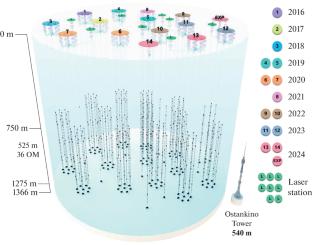机器学习在Baikal-GVD中的应用现状
IF 0.4
4区 物理与天体物理
Q4 PHYSICS, NUCLEAR
引用次数: 0
摘要
在本报告中,我们提出了基于机器学习的方法来分析贝加尔湖gvd数据。该框架解决了中微子探测中的五个关键挑战:抑制空气阵雨引起的事件,拒绝光模块的噪声激活,轨道和级联式命中的分类,中微子入射角度的重建以及能量估计。对于每个任务,我们讨论了物理动机并演示了性能指标。我们介绍了一个包含这些神经网络的数据处理管道,并讨论了它如何在贝加尔- gvd实验中提高数据分析的准确性和效率。本文章由计算机程序翻译,如有差异,请以英文原文为准。

Machine-Learning Applications in Baikal-GVD: Current Status
In this report we present machine-learning-based approaches for analyzing Baikal-GVD data. The framework addresses five key challenges in neutrino detection: suppression of air-shower-induced events, rejecting noise activations of optical modules, classification of track and cascade-like hits, reconstruction of neutrino incoming angles, and energy estimation. For each task, we discuss the physical motivation and demonstrate the performance metrics. We introduce a data processing pipeline that incorporates these neural networks and discuss how it can improve both the accuracy and efficiency of data analysis in the Baikal-GVD experiment.
求助全文
通过发布文献求助,成功后即可免费获取论文全文。
去求助
来源期刊

Physics of Atomic Nuclei
物理-物理:核物理
CiteScore
0.60
自引率
25.00%
发文量
56
审稿时长
3-6 weeks
期刊介绍:
Physics of Atomic Nuclei is a journal that covers experimental and theoretical studies of nuclear physics: nuclear structure, spectra, and properties; radiation, fission, and nuclear reactions induced by photons, leptons, hadrons, and nuclei; fundamental interactions and symmetries; hadrons (with light, strange, charm, and bottom quarks); particle collisions at high and superhigh energies; gauge and unified quantum field theories, quark models, supersymmetry and supergravity, astrophysics and cosmology.
 求助内容:
求助内容: 应助结果提醒方式:
应助结果提醒方式:


